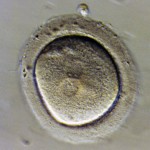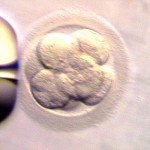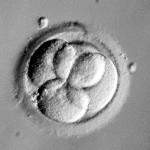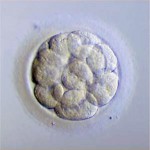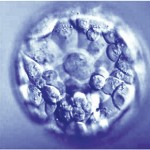Posts Tagged ‘family building’
Why Creating “McEmbryos” is Just Plain Wrong
Introduction
Recently, Alan Zarembo of the L.A. Times released a story alleging that California Conceptions was combining donated eggs with donated sperm and called them “donated embryos.” If there were leftover cryopreserved embryos, ownership of the embryos apparently went to California Cryobank (CC). If true, this is an egregious assault on reproductive ethics.
Defining embryo donation
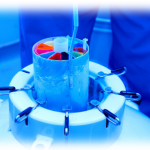
About one-third of all patients undergoing in vitro fertilization (IVF) will have excess embryos to cryopreserve. About one-half of these will not be used for reproduction by the patients who created them. (Bangsboll et al., 2004; Lyerly et al., 2010) Embryo donation occurs when patients with unused cryopreserved embryos make the amazing decision to pay it forward and donate their embryos to patients in need. In true embryo donation, the patients own the embryos and make disposition decisions regarding their embryos. It is estimated that 2-10% of all cryopreserved embryos are donated to patients in need.
Why is creating “McEmbryos” so wrong?
Allegedly, California Conceptions would use donor sperm and donor eggs to create embryos. At times, all the resulting embryos would be transferred simultaneously to numerous couples, each receiving approximately two embryos at a time. This would commonly be called a “split donor/donor cycle.” It is, however, an absolute misrepresentation to call them donated embryos. At least in this split donor/donor cycle scenario, where all the embryos were transferred, there would be no cryopreserved embryos left whose ownership was uncertain.
What if not all the embryos were transferred and some were cryopreserved? As I understand, CC transferred no more than two embryos at a time to numerous patients, with the remainder cryopreserved. The residual cryopreserved embryos became the property of CC.

According to the article, egg and sperm donor profiles are sent to prospective recipients. As soon as CC received a “buy-in” from a few patients, the “donor embryos” were created from the donor eggs and sperm. Who made the decision to combine these two donors? What happens to the left over cryopreserved embryos? The article stated that dozens of embryos would be created through the combination of a pair of donors with the embryos then frozen while CC looked for patients who wanted them. And yet, the clinic claimed to have only ten sets of cryopreserved “donated embryos” in their tanks at any given time.
While they stated they didn’t want to create a bank, it would appear that this is precisely what was being done.
I feel there is a potential conflict of interest on the part of any IVF facility regarding the disposition decision of any cryopreserved embryos that they own. Patients normally have options such as using them to build their family, donation to science, donation to a laboratory for quality assurance testing and personnel training, keeping them cryopreserved forever, and finally, donating them to patients in need (embryo donation).
With the methods described in the article, a number of logistical and ethical questions arise:
- Were the sperm and egg donors fully aware of what was to be done with the resulting embryos?
- How did the IVF practice decide which sperm and egg donors should be combined? Was this decision made through market research? If so, who made these decisions?
- Is anyone tracking where all these donor-donor conceived offspring end up?
- Who ultimately owns the cryopreserved embryos? In the article, the physician interviewed said the clinic owned them when they were frozen
- Who makes the disposition decisions regarding these embryos? Will the IVF facility that owns the embryos be likely to make disposition decisions that do not benefit their bottom line? Who has the best interests of the cryopreserved embryos at heart when the embryos are owned by the IVF facility? Is it possible that CC is the entity that is really “donating” their remaining cryopreserved embryos
- What happens to the cryopreserved embryos if the practice closes or is sold?
- Perhaps most important, although it may not be a problem presently but for the future, what happens to the cryopreserved embryos that are never chosen?
While certainly not meaning to demean the cryopreserved embryos, I can’t help but think of these dono/donor cryopreserved embryos as fast food embryos or “McEmbryos.” I can just see the patients coming in, looking above the cash register to the menu above and ordering a “Number 3,” which has a burger (i.e., bright, blonde-haired, blue-eyed egg donor) and fries (i.e., handsome, athletic and tall sperm donor) and ends up getting the order supersized to boot (i.e., requesting twins). I should write clearly that this is not the current method CC uses to to match recipients to remaining cryopreserved embryos but the slippery slope exists and other practices may eventually emulate this process
What did EDI try to do over the past year to remedy the problem?
We suspected what might be happening at CC well over a year ago but didn’t have proof. We approached the American Society for Reproductive Medicine (ASRM) who examined the information and eventually sent it on to the Society for Assisted Reproductive Technologies (SART). SART did an investigation agreeing with our preliminary assessment. Unfortunately, CC was not a member of SART so they had little influence with CC.
There was some discussion of placing CC on the Center for Disease and Control’s (CDC) radar, asking that they potentially audit CC. I am not aware if this was ever done.
There was some discussion of revising the Ethic’s Committee Opinion on embryo donation detailing the inappropriateness of creating “McEmbryos,” but in the recent revision sent out to all ASRM members to review this past August contained no such language. I contacted ASRM and volunteered to help write the couple of paragraphs that would address the issue but I was never contacted. My current understanding is that the ASRM Ethics Committee will be taking up this issue in the beginning of 2013 and I am hopeful they will make a stand against creating “McEmbryos.”
Is it really ASRM or SART’s fault?
ASRM and SART are membership organizations. Anyone can join ASRM whereas SART is only open to IVF practices. These entities are not designed to truly police their members. Certainly, they can bar them from membership, but let’s face it, this is really not much of a punishment. Most patients are not really aware if a practice is a member of either organization, so expulsion does more to protect ASRM and SART from criticism than it does to protect the patients.
In reality, I am not suggesting that ASRM or SART begin sanctioning their members. These organizations are made up of bright individuals wanting what is best for members and patients alike. I don’t believe ASRM or SART could ever expose themselves to legal liability and try to be anything more than what they were originally designed to be.
I feel criticism towards ASRM and/or SART is potentially misplaced. While I do feel these organizations can certainly take a stand against the creation of “McEmbryos,” they can only provide educational materials and information to members and patients. never entering the realm of fining, condemning practices or policing practices. That is simply not their job.
I am not being insensitive to the needs of the patients
California Conceptions is providing amazingly healthy embryos to patients in need. How could anyone not be touched the story twin girls born to a single 41 year-old woman? There is no question that the donor/donor split cycle can be far more cost effective than many other options. The ends to this process are what we all strive for – a healthy family.
Call me old-fashioned but I still feel there are instances where the ends cannot justify the means. Are we are loosing all respect for the embryos and treating them utterly as a commodity? The slippery slope is becoming quite steep. Are we ready for expanding banks of unclaimed embryos across the country owned by practices or physicians and not the patients? I’m sorry but the means being used here are fraught with uncertainty and may result in a list of unintended consequences.
What are the potential repercussions of the L.A. Times story?

At least this election year is over. I had grave concerns that the story would break early in the election cycle and would become a political football, resulting in a series of consequences around the country. I still believe we are at risk in the following ways:
- • Poorly designed and reactive legislation may yet be created on state or national level
- • This story may motivate the “Personhood” advocates by encouraging them to win personhood for embryos thereby protect them from becoming “McEmbryos”
- • There will be “guilt by association,” leaving other legitimate embryo donation facilities open to criticism and ridicule
- • All of this will reflect poorly on basic IVF facilities that are frequently viewed as unregulated, even though we are accountable to more regulatory agencies than any other area of medicine
There may be significant backlash regarding this story and we should all be prepared to answer questions that may arise from the media, our peers and our patients.
How can embryo donation programs hold but not own the donated embryos?
At Embryo Donation International (EDI), the embryo donors are still able to request that their donated embryos be returned if needed. For example, if the children of an embryo donor were tragically killed in a motor vehicle accident, it seems absolutely appropriate that the cryopreserved donated embryos should be sent back to the donors. To discourage this from being done without good reason, transportation costs for returning the embryos, which is estimated to be $300, are the responsibility of the original donors.
Once the embryos are transferred into the recipients, however, they now “own” them. In this way, EDI never truly owns the donated embryos. We are the conservator and protect the embryos while never making any disposition decisions regarding their fate. We never own the donated embryos and we encourage all embryo donation facilities adopt this model of conservatorship.
What can be done to correct the current problem?
- Various membership organizations such as ARSM, Pacific Coast Fertility Society (PCFS), SART and RESOLVE could release position statements condemning the creation of “donated embryos” without a destination. This could help guide public opinion.
- Perhaps the embryo donation programs would be willing to sign a contract stating that they will not participate in the creation of embryos without a destination. Programs willing to sign and honor the contract would be adhering to the highest of ethical standards.
- Through the court of public opinion and if the L.A. Times article is accurate, patients may no longer want to participate in what they feel in an unethical practice.
- Legislative action on the part of California may be necessary but this will take time and a great deal of expertise. We run the risk, however, of having well-meaning legislative actions spilling over and harming the process of embryo donation or IVF itself.
- CC itself may need to modify its business model by allowing patients to own the cryopreserved embryos.
From my perspective, we have a few options:
Something really needs to be done. I don’t feel that this unethical practice should continue. A corporation, business or physician practice should never own embryos, no matter how brief. These embryos are also not truly donated unless you feel CC is able to donate the excess cryopreserved embryos. The question is if we should play an active or a passive roll in determining what takes place. I personally prefer the active roll so you can count EDI in on doing our best to guide the process.
Sour grapes? Nope, just sour taste!
CC is a potential competitor of EDI. I have made this clear to each and every person I have spoken to regarding this current dilemma. When we were contemplating the expansion of our ten-year embryo donation program into EDI, we also looked at the option of a money-back guarantee such as is offered by CC. Understanding the delivery rates for recipients of truly donated embryos ranges from 27-45%, the likelihood of returning the majority of the payments back to recipients made it unlikely we could even keep our doors open. Most “shared risk” options also charge a premium on top of the normal fees. Recalling that embryo recipients are emotionally and financially drained, the idea of tacking on a large additional fee seemed unfair to the recipients and quite impractical to the process. Embryo donation works for recipients, in part, because it is more cost-effective than many other options.
So you see, it is not “sour grapes” that is guiding my writing; it is just a sour taste. If the article was accurate, I feel strongly that creating “McEmbryos” is an affront to IVF and embryo donation programs, misleading to embryo recipients and totally unfair to the cryopreserved embryos that are currently waiting to be chosen.
If you agree, please co-sign this blog….
We are going to do something a bit different with this blog. We are strongly encouraging not just the routine comments that follow our blog but we are also asking that practices, patients and interested parties who agree that creating “McEmbryos” is ethically inappropriate sign below. By endorsing the statement below, we will hopefully begin to separate ourselves from such entities that practice the “McEmbryo” method of “embryo donation,” moving forward with a resolution that will work best for all.
routine comments that follow our blog but we are also asking that practices, patients and interested parties who agree that creating “McEmbryos” is ethically inappropriate sign below. By endorsing the statement below, we will hopefully begin to separate ourselves from such entities that practice the “McEmbryo” method of “embryo donation,” moving forward with a resolution that will work best for all.
By signing below, I do hereby agree that creating banks of cryopreserved embryos is ethically unjustifiable and support sound solutions that will adhere to the highest of ethical standards supporting patients and cryopreserved embryos in the best possible way.
References:
Reasons to Donate
By: Vicki D., an embryo donor
“In the order of nature we cannot render benefits to those from whom we receive them, or only seldom. But the benefit we receive must be rendered again, line for line, deed for deed, cent for cent, to somebody.’ – Ralph Waldo Emerson, Compensation
On May 13, 2010, I made a decision. It wasn’t your normal everyday decision on things like what shoes to wear, where to have lunch, or which shade of lipstick to buy. It even surpassed those important decisions we encounter in life such as what house to buy, the most lucrative financial investments and selecting the best care for elderly parents. It was a decision much more substantial, incredibly emotional and most importantly, everlasting. It was regarding the fate of our embryos. Yes; five embryos, frozen, suspended in time – a significant and extraordinary reminder of a successful IVF cycle producing twin girls just two years prior. Considering that my family was now complete, the desire to have more children had abated. But the process was far from over and I knew this going in. There are five potential lives to consider currently residing in a sub-zero environment. So the question remained… what did one do with extra embryos when one’s need or desire to expand your family has subsided?
In my quest to determine the future of my five frozen embryos, I discovered several options to choose from. These ranged from permanent storage – or in some cases “abandonment,” destruction, donation to stem-cell research,  donation to the IVF clinic lab, or donation to an infertile couple or person in need. Continued voluntary storage brought unnecessary substantial fees, not to mention the inevitable procrastination of decision making. Abandonment wasn’t an option for obvious reasons as I felt a responsibility towards these embryos. The only things I have ever abandoned in my life were the occasional art project or my first premature marriage in my early twenties. The concept of destruction simply didn’t make logical sense. Why go through all the expense and trouble of creating embryos that one day would be destroyed because there was no better option considered? Stem-cell research or IVF clinic donation seemed like fair choices since I wouldn’t have my twins without past research in IVF. Even so, there had to be a better option available that would help promote the preservation of life and help out infertile couples desperately wanting a baby.
donation to the IVF clinic lab, or donation to an infertile couple or person in need. Continued voluntary storage brought unnecessary substantial fees, not to mention the inevitable procrastination of decision making. Abandonment wasn’t an option for obvious reasons as I felt a responsibility towards these embryos. The only things I have ever abandoned in my life were the occasional art project or my first premature marriage in my early twenties. The concept of destruction simply didn’t make logical sense. Why go through all the expense and trouble of creating embryos that one day would be destroyed because there was no better option considered? Stem-cell research or IVF clinic donation seemed like fair choices since I wouldn’t have my twins without past research in IVF. Even so, there had to be a better option available that would help promote the preservation of life and help out infertile couples desperately wanting a baby.
I remember the years of anguish I experienced being infertile. Everywhere I went I saw pregnant women or newborn babies. It became an obsession, perceived as something so intangible for me yet came so easily for others. There would be no remedy but a child. Why not help another couple expand their family? Why not help end the anguish? Why not “Pay it Forward” to the infertile community in such desperate need? The simplest answers to these questions became the best option.
So the decision came with three stages. Firstly, there was the genetic hurdle to consider. There is something about setting your genetic code, or more specifically, your potential genetic offspring, free into the world that can be somewhat unsettling. Where will these embryos end up, will they survive and what kind of life will they have? Will they know their history? Will they have questions? Will they look like me? But in the greater scheme of things, do these questions really matter?
The value and definition of family transcends any DNA makeup.
In the pursuit of the family unit, we tend to look beyond the genetic code and focus on the family element. The concept of having a family does not automatically equate to comparable genetic material as can be seen with any family with an adopted child. It’s about being part of a team, functioning as a whole and sharing your love and commitment to live and experience life together.
Secondly, there is an element of giving back; Paying it Forward to the infertile world. Donating the embryos was my way of paying back what I was so very fortunate to finally have – a family. Prominent memories of being unfulfilled without children are still fresh in my mind. I honestly believe that donating my idle embryos to someone in need helps to promote the probability of life.
And finally, chance. The chance to help someone build a family, the chance of potential life for the embryo, the  chance for you to give the greatest gift in life, the chance to take a chance! So for any of you out there who find yourselves with important decisions to make about your embryos in storage, think back a bit to your own infertile days. That memory will help guide you to do the right thing for someone with the same needs and desires as you have. Take a chance and do something good for humanity.
chance for you to give the greatest gift in life, the chance to take a chance! So for any of you out there who find yourselves with important decisions to make about your embryos in storage, think back a bit to your own infertile days. That memory will help guide you to do the right thing for someone with the same needs and desires as you have. Take a chance and do something good for humanity.
Donating the embryos was my way of paying back what I was so very fortunate to finally have – a family.
In the end I trusted Embryo Donation International (EDI) and Dr. Sweet with my precious embryos. I knew that with their high ethical standards and sheer devotion to the embryo they would give my embryos a chance at life, and hopefully help to build another family, just like they helped to build mine. And on every Mother’s Day ever since the donation I hope and wonder that by liberating my embryos they were able to help create another family somewhere out there and that they are as happy as I am.
Vicki D.
Mom, a Loving Wife and now, an Embryo Donor
torig71@gmail.com
How Does EDI Decide to Exclude Potential Embryo Recipients?

By: Craig R. Sweet, M.D.
Reproductive Endocrinologist
Info@EmbryoDonation.com
Introduction
There are times when we need to exclude patients when they contact Embryo Donation International (EDI) to become an embryo recipient. While not an easy decision or discussion, I thought it was time to explain our rationale when needing to, at least temporarily, exclude potential embryo recipients.
In a way, the blog we recently wrote on the ranking of potential embryo recipients dovetails into this discussion. In this blog, we described what we thought was an appropriate ranking system prioritizing those patients with the greatest need.
Our discussion here focuses on the patients who apply but who are never ranked because EDI feels they should be excluded because of any number of the reasons described below.
Excluding Potential Embryo Recipients Due to Maternal Risks
The decision to exclude a patient from embryo donation is really, in some ways, no different than the decision we have to make with other infertility patients.
Relative contraindications to pregnancy
There are occasions when certain conditions should probably be corrected before pregnancy takes place since pregnancy will often worsen or complicate the condition. Examples may include gallbladder disease and ovarian cysts or surface uterine fibroids that are five+ centimeters in average diameter. Treating these problems once pregnancy is established is very difficult, so it may be best to control the situation while we still can and correct the potential problem first before conception.
Strong contraindications to pregnancy
Patients who would be at significant risk of illness or even death should pregnancy occur include those suffering from cancer, poorly controlled systemic lupus, pulmonary hypertension or diabetes, to name a few important disease states.
Infrequently we have to be a bit paternalistic and say “no,” understanding that we may cause great harm to our ill patients by assisting them to become pregnant.
Excluding Potential Embryo Recipients Due to Risks to the Embryo/Fetus
The trickier decisions involve those patients where the potential for delivery of a live child is measurably reduced. Patients with decreased embryo implantation rates and those who are at an increased risk for spontaneous loss or at an increased risk for premature delivery/stillbirths fall into these categories.
Some of these examples are listed below:
|
Situation |
Decreased implantation |
Increased risk of spontaneous loss |
Increased risk of significant prematurity or stillbirth |
| Uterine cavity distorting fibroids or polyps |
x |
x | |
| Uterine fibroids 2+ cm in size located within the uterine muscle |
x |
x |
|
| Damaged uterine cavity with a thin endometrial lining |
x |
x |
|
| Hydrosalpinx where tubal fluid may flow back into the uterus |
x |
x |
|
| Unexplained recurrent pregnancy loss |
x |
||
| Uncontrolled medical conditions (e.g., hypertension, diabetes, renal disease, autoimmune disease) |
x |
x |
|
| History of an incompetent cervix |
x |
x |
|
| Persistent history of premature births |
x |
||
| Untreated pre-diabetes |
x |
x |
x |
| Obesity or morbid obesity* |
x* |
x* |
x |
* The effects of obesity or morbid obesity with regards to implantation rates and spontaneous loss rates are controversial.
The “Grey” Exclusion Zones
Out of the list above, one of the most difficult categories involves those patients who are obese or morbidly obese and their  potential reduction in implantation rates and increased spontaneous loss rates. Some articles show a significant reduction in implantation rates and an increased risk of spontaneous loss while others show contradictory results. While a comprehensive review of this topic goes beyond the scope of this blog, I believe there are a few things we understand:
potential reduction in implantation rates and increased spontaneous loss rates. Some articles show a significant reduction in implantation rates and an increased risk of spontaneous loss while others show contradictory results. While a comprehensive review of this topic goes beyond the scope of this blog, I believe there are a few things we understand:
- Patients with glucose intolerance and insulin resistance, regardless of weight, are at a higher risk of developing gestational diabetes during pregnancy and the potential complications associated with this disease.
- Patients who are obese or morbidly obese are clearly at risk during pregnancy for a host of issues, including preeclampsia, hypertension, large for gestational age babies, prematurity, stillbirths, gestational diabetes, Cesarean section deliveries and the risks associated with these surgeries.
There is only one preliminary study specific to embryo donation that did not show a consistent decrease in pregnancy rates as weight increased (Body Mass Index: BMI) but the trends were present suggesting an average reduction in overall pregnancy rate of 33% for obese and morbidly obese patients with a BMI of 30 or more. (Finger R., et al. 2011) We await the detailed publication of this important study to better understand this issue.
Weight loss is terribly difficult for patients and takes a great deal of time. Sometimes surgery, such as a gastric band or intestinal bypass surgery, may be the best option. These issues are the thorniest to decide, with pressure applied by potential embryo recipients who do not fully understand how their weight may contribute to failed implantation or pregnancy loss, though it certainly places them and their unborn offspring at greater risks during the pregnancy.
Surrogacy as an Option When Material/Embryonic/Fetal Risks are Too High
 Some of the issues discussed in this blog can be treated. Then the potential embryo recipient can be moved out of the exclusion zone. Some of these issues are not treatable, so options such as surrogacy and/or adoption may be better alternatives.
Some of the issues discussed in this blog can be treated. Then the potential embryo recipient can be moved out of the exclusion zone. Some of these issues are not treatable, so options such as surrogacy and/or adoption may be better alternatives.
While some embryo donation programs refuse to allow surrogacy, EDI feels this is an excellent alternative. For example, is it ethical for EDI to ask that the patient with asymptomatic uterine fibroids, which may significantly reduce implantation or increase pregnancy loss rates, be surgically removed in a patient who fears surgery? Is gestational surrogacy a better alternative?
In Summary
We do not mean to be cruel or judgmental but are forced to make difficult decisions regarding the acceptance or exclusion of embryo recipients. We owe it to the potential embryo recipients to give them the best chance possible, understanding there are medical conditions that may severely impair their chances for success. We owe a debt of gratitude to the embryo donors and take seriously the responsibility of finding a healthy patient for their embryos hoping to maximize the chances that the embryos will survive and thrive. Lastly, and certainly not least, we owe it to the embryos to make certain they have the best chance possible.
Unfortunately, we sometimes have to make the difficult decision to exclude a potential embryo recipient, at least temporarily, until the medial concerns are remedied or certainly improved.
References:
Finger R, et. al. Obesity and the ability to achieve pregnancy in embryo donation. Fertil Steril 2011;96(3)-S172.
Parent via Egg Donation – Parent via Embryo Donation

Marna Gatlin of PVED
Exploring what we know – Marna Gatlin, Founder Parents via Egg Donation and guest blogger
I was asked recently what I thought about embryo donation vs. egg donation. Is a parent via egg donation the same as a parent via embryo donation? What do they have in common? Or are they very different?
My knee jerk reaction was “Well doh, of course they are the same. They are both embarking upon a unique journey to become parents right?”
When I thought more about it, the word “versus” jumped out at me. Did the individual asking the question really mean “versus” as in against, or in contrast to?
Are the two mutually exclusive?
When I think of egg donation and embryo donation, I think about the word “AND” – I don’t think of it as an either or. Both are just different ways of either growing or adding to your family.
Some approach embryo donation with great trepidation because they worry about the bonding process, or about the explanation or story they will be sharing with their child. The reality is – the path might be different but at the end of the day the goal is the same – you are becoming a parent.
Let’s delve a little deeper. If you receive a donor egg, the genes of your baby are going to be combined with the genes of your husband (or partner) and those of your egg donor. Or if you are a single mother, or women in a same sex relationship, the donor egg will be combined with donor sperm. You will probably undergo what we call a fresh embryo transfer. You will carry that baby for nine months and then deliver that baby. Women often wonder if there’s a down side to carrying a baby that is not genetically related to them. You know this is an age old question that’s been asked and answered since the early 80’s when the first donor egg child was conceived, carried, and delivered. I can tell you as a parent via egg donation myself that it doesn’t matter. I carried my son for nine months. The bond I created with him is rock solid, loving, and he’s my son. The lack of genetic connection simply doesn’t matter. Not one iota. The very same thing happens with embryo donation recipient parents who are receiving truly a meaningful gift of life.
genes of your husband (or partner) and those of your egg donor. Or if you are a single mother, or women in a same sex relationship, the donor egg will be combined with donor sperm. You will probably undergo what we call a fresh embryo transfer. You will carry that baby for nine months and then deliver that baby. Women often wonder if there’s a down side to carrying a baby that is not genetically related to them. You know this is an age old question that’s been asked and answered since the early 80’s when the first donor egg child was conceived, carried, and delivered. I can tell you as a parent via egg donation myself that it doesn’t matter. I carried my son for nine months. The bond I created with him is rock solid, loving, and he’s my son. The lack of genetic connection simply doesn’t matter. Not one iota. The very same thing happens with embryo donation recipient parents who are receiving truly a meaningful gift of life.
The most beautiful aspect of embryo donation to me is that embryos that are being placed for donation are done so purposely. These are embryos that the donating parents know have created amazing children who are loved, honored and cared for. These donating parents want to make sure their embryos are donated to a home that will love, cherish and honor the resulting children as they would. Regardless of whether an individual has a child via egg donation or embryo donation, the fears of parenthood almost always focus on the unknowns. And here’s a secret: they are also experienced by those who are conceived naturally. Moms and Dads all over the world have the same worries about parenting as do parents via egg donation and embryo donation.
Parents via egg donation often ask questions such as:
- Am I going to screw up my child?
- Will my child love me?
- How am I going to relate to my child?
- Will my parents and other family members accept my child?
- How and when will I share information about their conception?
When we look at embryo donation the questions that we find unique to embryo donation are:
- Are we protected legally, can the donating parents come back and claim our child in the future? (The answer is NO, they cannot. That’s why it’s important to have a clear legal contract.)
- Will my child have access to information about his or her health in the future?
- Will my child have siblings and if so, will they have the opportunity to know them?
- Will my child or children see me as their real parent?
- How will I explain this to my family or friends?
- What about stupid comments from those around me?
- How and when will I share the information about my child’s conception with my child?
To me there is no difference between being a parent via egg donation or a parent via embryo donation. The end result is the same.
At the finish line we are simply Mom and Dad.
Marna Gatlin
Parents via Egg Donation
www.PVED.org | marna(at)pved.org
A little bit about Marna…
After many years of struggling with infertility, PVED founder Marna Gatlin discovered that the technology to have a child through egg donation was available. She was curious, excited, and above all, hopeful that this process might be the conduit to finally achieving her lifelong dream of becoming a parent.
Marna ensures that all the needs of egg donor recipients are met, maintaining a high standard of ethics and confidentiality. Marna advocates and assists recipient parents, helping them arrange for the highest quality patient care, wherever in the world they reside. Her experience and knowledge related to the complex emotional and physical needs of individuals dealing with infertility makes her an essential asset PVED.
As a previous recipient, Marna is uniquely qualified to provide caring and timely services. Marna is truly dedicated to compassionately guiding couples experiencing infertility through their treatment process.
Marna is joined by several dedicated and knowledgeable support staff that all work together clearly dedicated to see the success of PVED. These include clinical psychologists, reproductive endocrinologists, attorneys, as well as a talented business and public relations team.
Marna attended Eastern Oregon University and Portland State University majoring in Business, Psychology, Social Science, and is a member of the American Society of Reproductive Medicine (ASRM), the European Society of Human Reproduction and Embryology (ESHRE) and the Society for Assisted Reproductive Technology (SART). Marna, a writer, is married, has a son, and does some of her best thinking and creating atop of her John Deere tractor mowing and cultivating her back forty.
Do These Donated Embryos Make the Grade?
Embryo Grading Made Easy For Embryo Donors and Embryo Recipients
Part 1 of a 3 part mini-series by Corey Burke, B.S., C.L.S. & Laboratory Supervisor and Reproductive Endocrinologist Craig R. Sweet, M.D.
Embryo grading is an important factor for both donors and recipients. Potential embryo donors want to know if we will accept their embryos for donation since part of our decision is based on the grade of their embryos. Likewise, potential embryo recipients want to know how likely the donated embryos are to survive thawing and if they are of good enough quality to build their family. Part of our estimation of success depends on the grade of the embryos.
We wish this process could be easier since there is no standardized system used in all embryology laboratories to grade embryos. Furthermore, the grading of embryos is somewhat subjective so one embryologist may grade an embryo
somewhat differently than a colleague.
Embryo grading is an imperfect process; poorly graded embryos may occasionally result in ongoing pregnancies and beautiful looking embryos may not implant and grow. Poorer graded embryos will not necessarily result in an abnormal child; they simply seem to implant and grow less frequently.
So, the appearance and grading of an embryo is an imperfect estimate of the quality of the embryo as well as the embryo’s true potential. It is, however, the best way we have to visually estimate the implantation and live birth rate of a given embryo. We will now examine one of the more common methods used to grade embryos.
When are embryos graded and cryopreserved?
Embryos are usually graded and frozen at three specific stages with “Day 0” being the day of retrieval and fertilization:
| Age of Embryos | Day 1 | Day 3 | Day 5-6 |
| Common terminology | 2PN (pronuclear stage)
2 cell stage |
Embryos are 6-10 cells | Morula &
Blastocysts |
| Grading importance | Grading not available | Grading relatively important | Grading very important |
| How often these are sent to EDI? | Rarely sent | 40% of EDI embryos | 60% of embryos |
Embryos cryopreserved immediately after fertilization are confirmed early on Day 1 (the 2PN (pronuclear stage), but aren’t advanced enough to be consistently graded. Freezing embryos on Day 1 is quite infrequent unless we are certain there will not be an embryo transfer. Accordingly, these embryos are rarely sent to EDI for embryo donation.
Grading Day 3 Embryos
Day 3 embryos are graded on cell number, the amount of cellular fragmentation and the symmetry of the embryo.
Cell Number
Most Day 3 embryos will be comprised of 6-10 cells called blastomeres. Embryos with too few blastomeres may not be healthy, so we prefer at least 7-8 at this stage. Embryos with fewer cells may not be healthy growing very slowly or may have stopped growing entirely commonly called “cell block”.
Fragmentation
Fragments may be found in many of the embryos, which are “bits” of cells that break off from a blastomere. We prefer as little fragmentation as possible. Fragmentation is estimated as the percentage of fragmentation volume compared to the total embryo volume and is converted to a letter grade in the following way:
- 0 % = A
- 1-10% = B
- 11-25% = C
- >25% = D
A large amount of fragmentation may be caused by death of one or more of the blastomeres. The higher the fragmentation, the lower the quality of the embryo & letter grade and the less likely that the embryos will survive thawing. Embryos with high fragmentation rates implant less frequently when transferred fresh or when thawed.
Symmetry
Symmetry of the embryo refers to the shape of the individual blastomeres and the overall shape of the embryo. The blastomeres should all be very similar in size and generally round in shape. The scale used to grade symmetry is
- Perfect = A
- Moderately asymmetric = B
- Severely asymmetric = C
Severe blastomere asymmetry (i.e., large and small blastomeres in the same embryo) reflect nuclear/chromosomal and cytoplasmic problems suggesting the embryo is less healthy than desired. There is supporting evidence that blastomere symmetry is important and reflects overall health of the embryo. Interestingly, the overall symmetry of the embryo (round vs. oval) is of uncertain importance with some very “funny looking” embryos resulting in beautiful and healthy children.
Putting it All Together for Day 3 Embryos
For Day 3 embryos, the order of grading is the “number of cells (#c),” “fragmentation grade” and “symmetry grade”. For example:
- 7cAA = 7 cells with no significant fragmentation and perfect symmetry
- 8cBA = 8 cells with 1-10% fragmentation and perfect symmetry
- 6cBB = 6 cells with 1-10% fragmentation and moderate asymmetry.
Grading Day 5 Embryos
More advanced embryos are graded and potentially frozen on Day 5 or Day 6. These are generally described as morula or blastocysts.
Day 5 Morula Embryos
Morula embryos are difficult to grade as the cells combine, forming essentially a ball of cells that can’t really be categorized in any way other than descriptive terms:
- Morula (early)
- Compacting morula (more advanced)
While some facilities only occasionally cryopreserve Day 5 morula embryos, it is thought that the survival and implantation rates of these embryos may be slightly reduced but they are still quite reasonable, suggesting that they should not be discarded. Day 6 morulas are probably delayed in growth or may have stopped growing, may not be viable and are infrequently cryopreserved.
In order to balance the possible reduced implantation rates, it is common that more morula embryos are thawed and transferred in order to achieve success.
Day 5 Blastocyst Embryos
Day 5 blastocyst embryos are the most advanced embryos we see in IVF. These embryos are formed within 24 hour of actual implantation. Trying to grow embryos beyond this point is
technically difficult, as the embryos usually don’t survive. In addition, the window of time for implantation seemingly closes beyond Day 5 or early day 6. For example, transfer on Day 7 will rarely result in implantation. So, it simply makes more sense to transfer and/or freeze blastocysts rather than trying to grow them any further.
Along with descriptive measures, more objective grading is attempted through evaluation of the cellular expansion, the inner cell mass (which eventually becomes the fetus) and the quality of the outer cell mass called the trophectoderm (which eventually forms the membranes and placenta).
Expansion
As the embryo advances in growth, a cavity called the blastocoel fills with fluid. As the cells continue to divide and the fluid collects, the embryo expands and eventually escapes its outer covering called the zona pellucida. The blastomeres continue to group together wherein the individual cell cannot be counted. As the Day 5 embryo expands, differentiates and escapes the outer zona pellucida, the grade increases numerically from 1-5.
| Grade | Description | Physiology |
| 1 | Early Blastocyst | Starting to form a fluid-filled space in the middle (Blastocoel). Grading the embryo is difficult here. |
| 2 | Full Blastocyst | Blastocoel forms and inner cell mass is now distinguishable. Grading can be done from this point forward. |
| 3 | Expanded Blastocyst | Blastocyst is starting to expand in size thinning the outer covering, the zona pellucida |
| 4 | Hatching Blastocyst | Blastocyst is starting to hatch out of the zona pellucida. |
| 5 | Hatched Blastocyst | Blastocyst is fully hatched and now ready for implantation into the uterine wall. |
Inner Cell Mass (ICM)
As the blastomeres compact to form the inner cell mass (ICM), this early fetal tissue is graded on a A-D scale:
| ICM Grade | Description |
| A | ICM with total compaction |
| B | ICM still compacting |
| C | Reduced ICM |
| D | Poor with dying cells |
Trophectoderm (TE)
The outer cells of the trophectoderm (TE) also reflect the overall health of the embryo and are graded in an A-D scale.
| TE Grade | Description |
| A | Numerous cells forming cohesive layer |
| B | Few but healthy large cells forming a loose epithelium |
| C | Few cells present often with asymmetric distribution |
| D | Poor with degenerating/dying cells |
Putting it All Together for Day 5 Embryos
For Day 5 embryos, the order of grading is “expansion,” “inner cell mass” and “trophectoderm.” For example:
- 1 = Early blastocyst is unable to be easily graded with respect to ICM or TE as these haven’t separated well enough yet.
- 2BB = Blastocyst with partial ICM compaction with loose, large trophectoderm cells
- 3AB = Expanding blastocyst with total compaction of ICM and with loose, large trophectoderm cells
- 4AA = Hatching blastocyst with excellent ICM & trophectoderm cell layers
- 5AA = Fully hatched blastocyst with excellent ICM & trophectoderm cell layers
Day 5 embryos that are graded 4AA and 5AA are some of our favorite embryos.
Summary Comments
Embryology laboratories strive to grow the healthiest embryos they can. Over time, they have adapted different grading techniques so the laboratories can communicate the quality of the embryos to physicians, patients and each other. Not all beautiful embryos will implant or produce a healthy child but they seem to do so more often than others. Not all poorly developing embryos will fail to implant and produce a healthy child but most do not result in live offspring.
At EDI, we try to only accept embryos that are likely to implant so embryos with less than a B rating for any category are infrequently accepted. This is done to assure our recipients that all of the donated embryos we offer are of the highest quality and provided the greatest chance for a successful pregnancy.
This is only one piece of the puzzle as many other factors influence the likelihood for success. Dr. Sweet will cover this topic in the separate blog within the next couple of months.
Also stay tuned to the upcoming blogs regarding how embryos are frozen and thawed and what techniques seem to work the best.
While embryo grading is not a perfect system, we use it to try to predict the overall quality of the embryos and their potential to survive thaw, grow and build a recipient’s family.
Corey Burke. B.S., C.L.S.
Laboratory Supervisor
CBurke@EmbryoDonation.com
Craig R. Sweet, M.D.
Reproductive Endocrinologist
Info@EmbryoDonation.com
References
Racowsky C, Vernon M, Mayer J, Ball GD, Behr B, Pomeroy KO, Wininger D, Gibbons W, Conaghan J, Stern JE. Standardization of grading embryo morphology. Fertil Steril. 2010 Aug;94(3):1152-3.
How Does Embryo Donation International Rank Embryo Recipients?
Unfortunately, there are far more potential embryo recipients than donated embryos. While in this country alone, hundred of thousands of embryos are stored in liquid nitrogen, (Hoffman DI, et. al, 2003), less than ten percent and frequently less than five percent are donated to patients in need (Klock SC, et al., 2003). As a result, we often have a waiting list of recipients asking for donated embryos.
First, EDI doesn’t discriminate with respect to race, religion, ancestry, sexual preference or  marital status. We also try to be fair to existing EDI patients and to those who have yet to become established patients. We basically are looking for potential embryo recipients who have few other reproductive options available. If one views donated embryos as an essentially rationed commodity, we want to make certain that patients in greatest need are ranked the highest. We try to do this in an ethical and fair fashion but ranking them can be a challenge.
marital status. We also try to be fair to existing EDI patients and to those who have yet to become established patients. We basically are looking for potential embryo recipients who have few other reproductive options available. If one views donated embryos as an essentially rationed commodity, we want to make certain that patients in greatest need are ranked the highest. We try to do this in an ethical and fair fashion but ranking them can be a challenge.
While not absolute, below is a general ranking from high priority to lower priority in our general waiting lists:
- The intended parents have no delivered children and limited financial means with few options available.
- Their only child died and no other siblings exist.
- One of the partners raised a child with a different partner.
- Both of the partners raised children with different partners.
- Both partners raised one adopted child together.
- Both partners raised one (genetic) child together.
- Both partners raised children with other partners and one (genetic) child together.
- Both partners raised multiple (genetic) children together.
We define a “genetic child” as a child whose genes came from the parents themselves without the use of donated material and also not an adopted child.
Here are some of the questions we also commonly ask in trying to decide where the patients should rank on our waiting lists:
- How long have they been on the waiting list?
- Are they established patients with EDI or have never been seen before?
- Are there other less expensive and viable options such as donor sperm?
- What have the patients gone through during their infertility journey?
- Is adoption of a live child a possibility?
- Are there financial constraints that makes embryo donation far more feasible over other more expensive options?
Also, we actually have multiple lists broken down by the following major categories:
- Type of embryo donation: Anonymous, Approved and Open Embryo Donation
- Marital status/sexual orientation: Single woman, single man (very rare), heterosexual couple (married/unmarried), lesbian couple and gay couple (married/unmarried).
 As you can see, the process of ranking can get a bit complicated. Our highest priority is healthy embryo recipients who have never had children of their own and have very few fertility options with limited financial means. For example, this group may include cancer survivors who have been left infertile due to the disease or treatment. In many states, cancer survivors find adoption of a child extraordinarily difficult, so embryo donation may be their only option for building a family. We also tend to rank patients higher who have undergone extensive unsuccessful IVF treatments and egg donation is their only remaining option, but due to financial constraints, are unable to afford the procedure.
As you can see, the process of ranking can get a bit complicated. Our highest priority is healthy embryo recipients who have never had children of their own and have very few fertility options with limited financial means. For example, this group may include cancer survivors who have been left infertile due to the disease or treatment. In many states, cancer survivors find adoption of a child extraordinarily difficult, so embryo donation may be their only option for building a family. We also tend to rank patients higher who have undergone extensive unsuccessful IVF treatments and egg donation is their only remaining option, but due to financial constraints, are unable to afford the procedure.
While we do not exclude patients who have raised children, some requests come from parents with numerous children in their current family. We are actually not looking for potential embryo recipients who are trying to “save” donated embryos. We wish we had enough embryos for everyone, but until we have more embryos than applicants, we will continue to prioritize patients who have never raised children higher than those who have previously experienced the joys of parenthood. We will not exclude such patients, they will be ranked far lower than others on the priority scale.
While some patients who approach EDI have no children, they may have several other fertility options. For example, a young couple that is infertile due to severe male factor infertility, may best be served with sperm donation. Donor sperm generally is less expensive and faster than embryo donation and they can have more than one child using the same donor. We would prefer to save the donated embryos for patients with few available options.
We hope that our readers will understand our basic goals. For any rationed commodity, we want to save it for those in greatest need. If one pictures the embryos as rare, precious and hard to come by, one can imagine why a fair ranking system must be developed.
Ranking systems are never perfect and often seem unfair to those who receive lower rankings. It is difficult to explain a lower ranking to a patient who is desperately seeking to build or expand their family, however, once separated from the emotional aspect, it is usually agreed that a ranking system is needed to fairly as many patients that we can who are seeking donated embryos.
In summary, we feel that a ranking system is necessary to achieve our goal of matching donated embryos to patients in need in an ethical and fair fashion. In a perfect world, infertility wouldn’t even exist and there would be enough donated embryos to meet the demands of those asking for donated embryos. In today’s realistic world, however, the precious gift of donated embryos is simply not given often enough to meet the demands of those seeking donated embryos. Perhaps someday ,though education and research, the number of patients offering their embryos for donation will increase to such a level that we may be able to eliminate or at least trim back segments of our ranking system. Until that day comes, we will have to do our best to assist in matching patients in need to donated embryos in the most ethical and fair fashion we can.
Shelley Osking, L.P.N.
Embryo Donation Coordinator
Shelley@EmbryoDonation.com
Corey Burke, B.S., C.L.S.
Laboratory Supervisor
CBurke@EmbryoDonation.com
Craig R. Sweet, M.D.
Reproductive Endocrinologist
Founder, Medical and Practice Director
Info@EmbryoDonation.com
Hoffman DI, et al. Cryopreserved embryos in the United States and their availability for research. Fertil Steril 2003;79:1063-9.
Klock SC, et al. The disposition of unused frozen embryos [letter]. N Engl J Med 2001;345(1):69-70.
Georgia Law: The First Salvo Towards Embryo Personhood
A Guest Post by: Harold Eskin, Esq.
New laws are beginning to appear on the books of many states that support “embryo adoption.” “Embryo Adoption” is placed in quotation marks because that phrase alone has unique connotations that I discuss briefly below. The term embryo “donation” is also a commonly used expression describing giving one patient’s/couple’s cryopreserved (frozen) embryo(s) to another patient/couple trying to expand their family, but who otherwise have been unsuccessful through natural and/or advanced reproductive techniques.
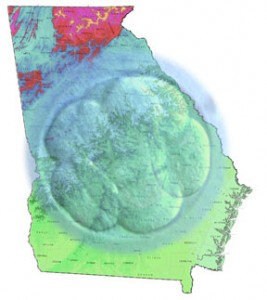 Georgia was the first state to pass an embryo adoption bill (2009) that provided an opportunity for intended parents to go through an adoption procedure to obtain the right to gestate a thawed frozen embryo. Other states, such as Florida, have embryo donation statutes on its books, which allow a couple to receive a donation from another (open or anonymous) of a frozen embryo. While the end results may appear to be the same, the road getting there and implications of using the different phrases are vastly different.
Georgia was the first state to pass an embryo adoption bill (2009) that provided an opportunity for intended parents to go through an adoption procedure to obtain the right to gestate a thawed frozen embryo. Other states, such as Florida, have embryo donation statutes on its books, which allow a couple to receive a donation from another (open or anonymous) of a frozen embryo. While the end results may appear to be the same, the road getting there and implications of using the different phrases are vastly different.
The Georgia law, which was championed by Right to Life groups, treated a frozen embryo in much the same way as it would a child already born. The new law and procedures mimic that of other adoption provisions and gives the frozen embryo many of the same rights and considerations of a born child, including using a “best interest of the child” standard in the adoption analysis. This philosophy is consistent with the concept that a child’s rights (as compared to the mother’s) begins at conception rather than birth and has implications in the abortion-right to choose/right to life arguments ongoing disagreements and potential laws expressing same.
Florida and many other states have historically treated frozen embryos as the property of the parents, who have the right to donate or dispose of the frozen embryos as they saw fit. The recipients received the frozen embryos as property under the respective laws of their state and could use or dispose of the frozen embryos as they saw fit. This process allowed for freer access to unused frozen embryos and discouraged the abandonment/discarding of them.
The agenda of the Georgia law was not necessarily meant to “protect” the frozen embryos but was designed to advance a political agenda of creating additional barriers to a women’s right to choose (i.e. restrict abortion) and to further control the reproductive rights of patients by discouraging the use of advanced reproductive techniques, such as in vitro fertilization as well as the cryopreservation and storage of excess embryos.
Up to now, there have been few attempts to export the Georgia concept in other states. This is perhaps due to the country’s economic challenges, but this possible trend needs to be closely monitored. The implications of providing “personhood” to embryos are far and wide and the Georgia statute is one of the first successful salvos to be launched with others most certainly to follow. Mississippi is currently targeted for a constitutional amendment to give embryos personhood and many other states are next in line for challenges that may significantly impair the health and reproductive care of women.
Harold Eskin, Esq.
www.LegalSurrogacy.com
HalEskin@LegalSurrogacy.com
1420 SW 47th Street
Cape Coral, FL 33904
239-549-5551
References:
Georgia Statute:
http://statutes.laws.com/georgia/title-19/chapter-8/article-2/19-8-41Florida Statute:
http://www.leg.state.fl.us/Statutes/index.cfm?App_mode=Display_Statute&Search_String=&URL=0700-0799/0742/Sections/0742.14.html
Hope & Will Have a Baby – Book review by Craig R. Sweet, M.D.
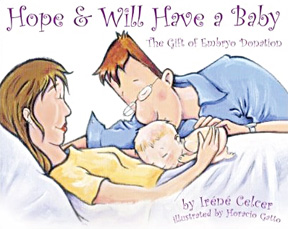 This book is one of a collection of third party conception children’s books written by the same author and illustrator and published by Graphite Press, copyright of 2006. It is one of the only books I have seen for children conceived though embryo donation.
This book is one of a collection of third party conception children’s books written by the same author and illustrator and published by Graphite Press, copyright of 2006. It is one of the only books I have seen for children conceived though embryo donation.
Ms. Celcer is a mental health professional that feels it is important to be up front in telling the children of embryo donation about their origin. In her forward, she cites the past secrets in adoption causing harm. She goes on suggesting that-
- • Children somehow sense the secrets
- • The failure to divulge may create shame in the parents of donated embryo offspring
- • Failure to tell a child results in a loss of pride of their beginnings
This book is to be used to tell the children about their loving conception while trying to manage the complex emotions of the parents.
Through the eyes of Hope and Will, a young married couple in love, the book explains what a “special place” the uterus is and how  embryos are created. Hope and Will experience infertility, depression and probably some grumpiness (can you imagine?). They seek help through Dr. Quest, who gives Hope tablets, pills and shots, but to no avail. Embryo donation is discussed, explaining anonymous and open options in simple and easy to understand terms.
embryos are created. Hope and Will experience infertility, depression and probably some grumpiness (can you imagine?). They seek help through Dr. Quest, who gives Hope tablets, pills and shots, but to no avail. Embryo donation is discussed, explaining anonymous and open options in simple and easy to understand terms.
Hope and Will conceive though embryo donation. The author emphasizes love, pride and excitement when the delivery finally takes place. Hope and Will are clearly grateful to their donor couple whom they have never met. Enough information is provided about the donors to help the child understand his origin.
While perhaps a little complex for a young child of four or five, the book might work quite well for a slightly older child. The pictures are wonderful and the emphasis on love and the desire to have a child by whatever means necessary is well done. I have always suggested that if parents tell the child, they should highlight their tremendous desire to have and love that child, as well as how hard they worked to bring such a wonderful child into their home.
Disclosure in embryo donation is a periodic theme of a number of my blogs. Adoption is clearly different than embryo donation. Adoption tends to be well accepted by most of the world’s religions. If embryo recipients tell friends, family and their donor-conceived offspring, there may be significant repercussions. Will the recipients and offspring be criticized, ostracized or, even, excommunicated by these same people or by their own religion?
Unfortunately at this time, I simply don’t believe we have enough data to make a clear recommendation to embryo recipients although there is wonderful ongoing research that will hopefully help to answer this question. For now, extrapolating what we have learned from adoption may simply not be appropriate for embryo donation, although passions on both sides of this issue 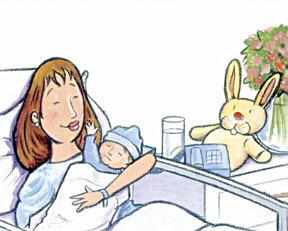 abound. The long-term consequences of secrecy vs. total openness to friends, family and the child of embryo donation are essentially unknown and I feel this decision needs to be made carefully with consultation with skilled mental health professionals (and Ms. Celcer is one of them), reproductive endocrinologists and perhaps, most importantly, recipients that have already traveled this journey.
abound. The long-term consequences of secrecy vs. total openness to friends, family and the child of embryo donation are essentially unknown and I feel this decision needs to be made carefully with consultation with skilled mental health professionals (and Ms. Celcer is one of them), reproductive endocrinologists and perhaps, most importantly, recipients that have already traveled this journey.
Selling for about $20 at Barnes & Noble, the purchaser should know this is a paperback and only 28 pages. The reader is clearly paying for the content and not story length or volume.
I highly recommend this book for those parents who decide to tell their child they were conceived through embryo donation, although the story line may need to be changed for single women and gay and lesbian couples. For the lucky parent(s) of embryo donation, this is a fairly good place to start if disclosure is the path they choose to follow.
Craig R. Sweet, M.D.
Founder, Medical & Practice Director
Embryo Donation International
Part 2: Disclosure from the Perspective of the Embryo Recipient
This is Part 2 of the Disclosure From the Perspective of the Embryo Recipient series. If you missed Part 1 and want to catch up, please scroll below or click here. In the week prior, we also covered the same disclosure issue but from the perspective of the embryo donor, scroll further down or click Part 1 and Part 2. More is yet to come in the two weeks ahead as we continue to evaluate this topic that is important to so many.
 When is the Best Time to Disclose Embryo Donation to the Child?
When is the Best Time to Disclose Embryo Donation to the Child?
If parents decide to disclose, it is seemingly better to do so earlier rather than later. Disclosing to a young child allows the child time to absorb the information. If disclosure occurs in adolescence or later, the young adult may feel mistrust, alienation, identity confusion, frustration and even hostility towards his or her family (Ethics Committee, 2004 & Mahlstedt PP, et al. 2010). About 46% of the donor sperm offspring who were told at the age of 18 or older stated they were confused about the disclosure. According to the research published, it seemed as though it was best to tell the child before the age of 10 because waiting doubled the number of children who were unsettled with the information.
How Often Do Offspring Inadvertently Discover Their Origins?
The most common reason for embryo recipients to disclose was a fear that the child would accidently discover the facts at a later date (MacCallum F, et al. 2007). When recipients are considering embryo donation, they commonly toss the idea around with friends and family. I urge caution here. The more people who know of their decision to be embryo recipients the greater the likelihood that offspring may discover their origins.
Even if the recipient parents keep the information to themselves, the children may still find out. One study of adult offspring of sperm donation found that about one-third of the individuals learned of their donor origins after an argument, from another person or they figured it out themselves (Mahlstedt PP, et al. 2010). In a recent study, about 10% (47/458) of the sperm donor offspring who were searching for their donors and half-siblings found out by accident (Beeson DR, et al. 2011). They either were apparently told by siblings, family or friends; discovered paperwork or unusual medical issues, overheard parents talking or learned as a consequence of divorce. Though sperm, egg and embryo donation procedures differ in many respects, when examining these two studies it is clear that there is a reasonable risk that the offspring will discover their origins even in the best of circumstances.
Are Embryo Donor Offspring Harmed by Non-Disclosure?
Interestingly, children do not seem to be harmed if disclosure does not occur. Also, if disclosure occurs early, neither the children nor the family seem to be harmed (MacCallum F, et al. 2007 & 2008).
Should Disclosure be Mandated?
Many hope that egg and sperm donation programs can move from strategies focused on compensation to a more altruistic perspective (Scheib JE, et al. 2008). Embryo donation is quite different since financial incentives, if they exist at all, are minimal and altruistic reasons for donating are currently the primary emphasis.
Unfortunately there is a much greater preference to discard or abandon embryos than to donate them. Placing any impediments to embryo donation, such as mandating disclosure, may not only reduce the number of embryos donated but will almost certainly result in a greater number of embryos discarded or abandoned. I cannot imagine that advocates for mandated disclosure would want the loss of embryos and potential families to be the unintended outcome.
There also has also been a push to create a national registry for egg and sperm donation (Ravitsky V, et al. 2010). Embryo donation might also be included in this process. Amongst many issues involved in such a registry, the following concerns exist:
- Who would pay for the registry?
- What information would be kept?
- Who has have access to the information?
As a field, we must be concerned about the safety of medical information of such as a private nature and which previously was privy to only a few people. It is frightening to learn how unsecured online medical information has become. These are real privacy concerns about millions of health records left unprotected, as reported by the government.
If a national registry actually is established, who will pay for it? Who will have access to it? Can you imagine the terrible impact it might have if someone hacked into the database and either released the personal medical information or tried to blackmail parents so that disclosure wouldn’t occur?
Until better safeguards can be designed, I will have significant concerns that private medical information will not be safe in a national registry.
Summary Comments
The decision to disclose the use of donated embryos to create a family is an extraordinarily difficult one for embryo recipients. As will be discussed in a future blog, discussions with mental health professionals are not adequate to help recipients make this decision.
I feel that if the recipient starts to tell friends and family that donated embryos were used, the need for disclosure grows significantly. It is very destructive for children conceived through third party assistance to find out their origins during adolescence and beyond.
One of the common reasons given for not disclosing is fear that the non-genetic parent will be rejected. Actually, there is no data to support or deny this concern. Embryo recipient parents seem to make great parents and the children are well adjusted regardless of disclosure decisions. That stated, it is pivotal that unintended disclosure not take place as this can cause irreparable harm to the family as a whole.
While counseling with a mental health professional is encouraged, their tendency to immediately equate embryo donation with adoption shows bias in suggesting uniform disclosure. Patients want support and guidance as they work through the difficult decisions but do not want to be told what to do.
The discussion of infertility is less of a taboo but there are still areas of society as well as some religions that will reject the child and the family created through donor eggs, sperm and embryos, causing potential harm to all. It is not for me to say that disclosure is right or wrong. It is my place to help educate the donors and recipients so that they can make the best decision for themselves and their embryo donor children.
The Last Survey In The Series:
To make this discussion as interesting and as current as possible, I will ask that the reader participate in the following survey. The survey below is to be taken assuming you were the offspring of embryo donation. I will summarize the results of this survey in the next blog while reviewing the information we know about the disclosure issues from the perspective of the embryo donor offspring.
Please ask your family, friends and anyone else interested to join in the survey and add comments to the blog as we wade together through the complex issue of disclosure of the embryo donation process to others, especially the child.
Survey: “Imagine You Were an Embryo Donor Offspring”
Next Week:
Please be sure to watch for our next blog that will be titled, “Embryo Donation Disclosure Issues From the Perspective of the Embryo Donor Offspring”.
References: Ethics Committee of the ASRM. Informing Offspring of their conception by gamete donation. Fertil Steril 2004;81(3):527-31.
Golombok S, Lycett E, MacCallum F, Jadva V, Murray C, Rust J, Abdalla H, Jenkins J, Margara R. Parenting infants conceived by gamete donation. J Fam Psychol. 2004 Sep;18(3):443-52
Klock SC. The controversy surrounding privacy or disclosure among donor gamete recipients. J Assist Reprod Genet. 1997 Aug;14(7)-378-80.pdf
Jadva V, Freeman T, Kramer W, Golombok S. The experiences of adolescents and adults conceived by sperm donation: comparisons by age of disclosure and family type. Hum Reprod. 2009 Aug;24(8):1909-19.
MacCallum F. Embryo donation parents’ attitudes towards donors- comparison with adoption. Hum Repro 2009;24(3)-517-23.
MacCallum F, Golombok S, Brinsden P. Parenting and child development in families with a child conceived through embryo donation. J Fam Psychol. 2007 Jun;21(2):278-87.
MacCallum F, Keeley S. Embryo donation families: a follow-up in middle childhood. J Fam Psychol. 2008 Dec;22(6):799-808.
Mahlstedt PP, LaBounty K, Kennedy WT. The views of adult offspring of sperm donation: essential feedback for the development of ethical guidelines within the practice of assisted reproductive technology in the United States. Fertil Steril. 2010 May 1;93(7):2236-46.
Ravitsky, V. & Scheib, J.E. (2010). Donor-conceived individuals’ right to know. Hastings Center Bioethics Forum 2010;40:(4).
Scheib JE, Ruby A. Contact among families who share the same sperm donor. Fertil Steril. 2008 Jul;90(1):33-43.
Shehab D, Duff J, Pasch LA, Mac Dougall K, Scheib JE, Nachtigall RD. How parents whose children have been conceived with donor gametes make their disclosure decision: contexts, influences, and couple dynamics. Fertil Steril. 2008 Jan;89(1):179-87.
Disclosure Issues From the Perspective of the Embryo Donor
This is the second of a five-part series by Dr. Craig R. Sweet examining the complex decision-making surrounding the disclosure of the genetic origins of embryo donor offspring to family, friends and the children themselves.
If embryo donors are kind and generous enough to donate their unused frozen embryos to patients in need, their next important decision revolves around whether they want to donate anonymously or if they would like to create some type of relationship with the recipients and their potential offspring. At EDI we want to give donors the widest range of choices, so we offer Anonymous, Approved and Open Embryo Donation procedures.
We do not have accurate national statistics about which embryo donation procedure is chosen most often. Some matching  organizations only deal with open procedures while many reproductive facilities only offer anonymous arrangements. Embryo donors, therefore, often have to search for the facility that will cater to their needs.
organizations only deal with open procedures while many reproductive facilities only offer anonymous arrangements. Embryo donors, therefore, often have to search for the facility that will cater to their needs.
Is Adoption the Best Model To Follow?
I have written about why I believe the term “embryo adoption” should not be used in the context of embryo donation and the American for Reproductive Medicine has a similar perspective. Regardless of our beliefs, some donors feel a responsibility to the embryos that includes making certain the embryos are donated to a loving and safe home. These donors feel the process is similar to adoption.
Over the years, there has been a trend in traditional adoption towards providing adopted offspring with information about their genetic parents after they turn 18 years of age. This trend towards disclosure is being used to encourage more open procedures in embryo donation. But there is a major difference between the two forms of family building: embryo donation offspring do not have to be told of their origins. Because the recipient carries and delivers the child, it is completely possible to keep the “non-genetic” relationship a secret from family, friends and the child. The donor offspring-recipient relationship begins differently than adoption from legal, emotional, social and practical perspectives.
Embryo donors and the genetic parents of a newborn are able to stipulate what kind of recipient will be given their embryos and newborn. While they will state they are doing what is best for the child, some may argue they are doing what is best for themselves. In the case of child neglect/abuse/abandonment, the courts and case workers will decide what they feel is best for the living child. In this situation, the needs of the child take priority over the perceived needs of the genetic parents. Embryo donation always focuses on the needs of the parents while adoption may focus on the needs of the child.
Are Embryo Recipient Families and Offspring Happy?
Embryo donors may worry about the kind of home in which the potential children of their donated embryos will be raised. Results from recent research can help mitigate these concerns since it appears that embryo donation families are more child-centered than adoptive and other IVF families (MacCallum F, et al. 2007 & 2008). This may be due in part to the recipients’ older age and maturity compared to their younger IVF and adoptive parents. Given their strenuous attempts to conceive, the embryo recipients seem to be extraordinarily appreciative of their gift, making their homes more child-centered and the children seem to be well attended.
 Unlike adoption, it is doubtful that the offspring of embryo donation will have the “history of rejection” to resolve like adopted children might have after being separated from their birth parents (Widdows H, et al. 2002). Although studies are lacking, this hurtle doesn’t seem to exist for children created from embryo donation. Indeed, though the donors felt their own family building was complete, they also felt strongly about giving their unused embryos a chance at life as well as wanting to “pay it forward” to deserving recipients. Families created through embryo donation are a product of a loving gift and not formed from rejection.
Unlike adoption, it is doubtful that the offspring of embryo donation will have the “history of rejection” to resolve like adopted children might have after being separated from their birth parents (Widdows H, et al. 2002). Although studies are lacking, this hurtle doesn’t seem to exist for children created from embryo donation. Indeed, though the donors felt their own family building was complete, they also felt strongly about giving their unused embryos a chance at life as well as wanting to “pay it forward” to deserving recipients. Families created through embryo donation are a product of a loving gift and not formed from rejection.
It would, therefore, appear that the offspring created through embryo donation do not have to have a relationship with the embryo donors to be well adjusted. While it may be desired and perhaps even preferred by offspring, it remains the embryo donor’s choice at this early stage of the game.
What Options Are Readily Available?
I believe that in most Open Embryo Donations, the child will be told of their origins. In fact, contracts may stipulate that the donors have the right to contact the child at a later date or may provide a mechanism for the child to be able to contact the donor at a certain age. An Open Embryo Donation process more closely mirrors an adoption process.
For Anonymous Embryo Donation, EDI is considering Open-Identity, an intermediate option allowing embryo donor offspring access to medical and other types of information after they reach a specified age. A number of steps are needed for open-identity to work:
- Embryo donors must agree to an anonymous process with the option of open-identity at a later date.
- The embryo recipients are not mandated to disclose, so only those offspring who are told may seek contact with the donors.
- If the embryo donor offspring desire contact, they will notify the clinic that performed the embryo donation procedure to access identifying information.
- It is essential that the embryo donors maintain contact with the embryo donation facility so that up-to-date identifying information is available.
I find it curious that most open-identity procedures, such as in adoption, identifying information is only provided at or beyond the age of 18. I can’t help but wonder if the child would be better served by having contact earlier, especially if it is truly desired by all parties. If the donors and recipients agree, why not initiate contact earlier, such as in the formative years? The respondents to our first poll seem to agree with the vast majority favoring an open-identity disclosure before the age of 18.
We will continue this discussion, on disclosure issues from the perspective of the embryo donor tomorrow and also launch the second of our three surveys. The reference list will also be posted with this second half tomorrow. Stay tuned!
